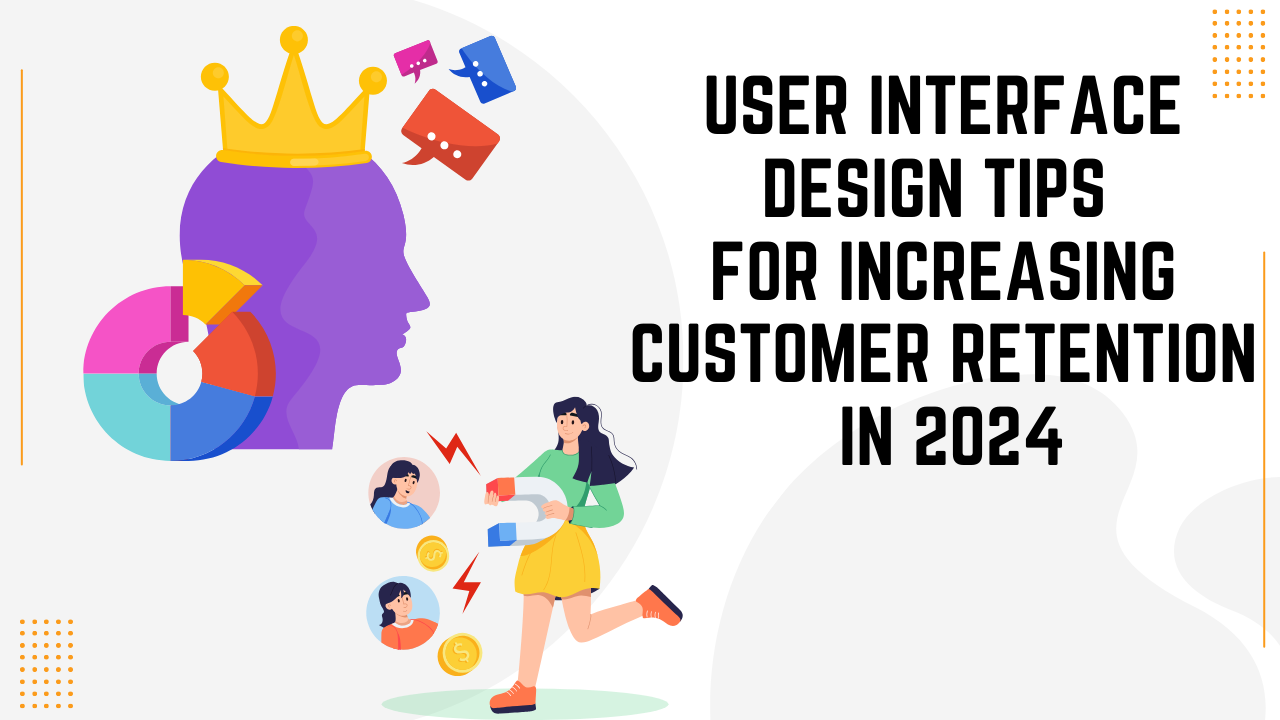In the ever-evolving digital landscape, customer retention has become a focal point for businesses looking to sustain growth and profitability. With users inundated with options, creating a memorable experience that keeps customers returning is essential. User interface (UI) design plays a pivotal role in this process. A well-crafted UI can significantly enhance user experience (UX), leading to increased customer satisfaction and loyalty. This article delves into effective UI design tips to boost customer retention in 2024, focusing on current trends, best practices, and actionable strategies.
Understanding the Importance of User Interface (UI) Design in Customer Retention
Before diving into specific design tips, it’s crucial to understand why user interface design is integral to customer retention. The UI is the point of interaction between the user and your product or service. A user-friendly interface can lead to positive experiences, while a poorly designed UI can frustrate users and drive them away.
Research shows that users form their first impressions within seconds of interacting with a product. A seamless and aesthetically pleasing UI fosters trust and confidence, encouraging users to explore further. Furthermore, a well-designed interface can reduce the learning curve, enhance usability, and ultimately increase the likelihood of repeat visits.
Prioritize User-Centric Design
Understanding Your Audience
To create an effective UI, start by understanding your target audience. Conduct user research to gather insights about their preferences, behaviors, and pain points. Tools like surveys, interviews, and user testing can provide valuable data to inform your design decisions.
Creating Personas
Develop user personas that represent different segments of your audience. These personas will help guide your design process, ensuring that the UI caters to the needs and expectations of your users.
Embrace Simplicity and Minimalism
Keep It Clean
A clean and minimalist design is not only aesthetically pleasing but also enhances usability. Avoid cluttering the interface with unnecessary elements. Focus on essential features and information, allowing users to navigate effortlessly.
Whitespace Matters
Utilize whitespace effectively to separate elements, improve readability, and draw attention to key areas of the interface. Whitespace can create a more relaxed and less overwhelming experience for users.
Consistent Branding and Visual Hierarchy
Establishing Brand Identity
Your UI should reflect your brand identity consistently. Use a cohesive color palette, typography, and imagery that aligns with your brand values. This consistency fosters familiarity, making users more comfortable and encouraging them to return.
Creating Visual Hierarchy
Establish a clear visual hierarchy by strategically arranging elements based on their importance. Use size, color, and contrast to guide users’ attention. Important actions should be prominently displayed, while secondary options can be more subdued.
Optimize for Mobile Devices
Responsive Design
With the increasing reliance on mobile devices, ensuring that your UI is responsive is crucial. A mobile-friendly interface should adapt seamlessly to different screen sizes and orientations, providing a consistent experience across devices.
Touch-Friendly Elements
Design UI elements to be touch-friendly, ensuring they are appropriately sized for tapping and swiping. Avoid placing clickable items too close together, as this can lead to user frustration and accidental clicks.
Enhance Navigation
Intuitive Navigation
Make navigation intuitive by organizing information logically and using familiar patterns. Users should be able to find what they need quickly and without confusion. Implement clear labels and icons to guide users through your interface.
Search Functionality
For content-heavy applications, incorporate a robust search feature that allows users to find specific information easily. Autocomplete suggestions and filters can enhance the search experience, making it more efficient.
Personalization and Customization
Tailored Experiences
Leverage user data to create personalized experiences. This could include recommending products based on previous purchases or allowing users to customize their dashboards. Personalization makes users feel valued and increases their likelihood of returning.
User Preferences
Provide options for users to customize their experience, such as choosing themes, layouts, or notification settings. When users have control over their experience, they are more likely to engage and remain loyal.
Focus on Performance and Load Times
Fast Loading Times
Performance is critical in UI design. Users expect fast-loading interfaces; delays can lead to frustration and abandonment. Optimize images, scripts, and other assets to ensure quick load times.
Feedback Mechanisms
Incorporate loading indicators and feedback mechanisms to keep users informed while they wait. This can mitigate frustration by showing that the system is actively working on their request.
Use Engaging Visual Elements
High-Quality Imagery
Incorporate high-quality images and graphics that resonate with your audience. Visual elements should complement the overall design and support the content without overwhelming the user.
Microinteractions
Implement micro interactions—small animations or design elements that provide feedback or guide users through actions. These subtle enhancements can create a more engaging experience and keep users invested in the interface.
Build Trust with Transparency
Clear Communication
Establish trust by being transparent about data usage, privacy policies, and terms of service. Communicate how user data will be handled, and provide options for users to manage their preferences.
Security Features
Incorporate visible security features, such as SSL certificates or trust badges, to reassure users about the safety of their information. Users are more likely to return to platforms they trust.
Gather Feedback and Iterate
User Feedback Loops
Establish feedback loops to gather user opinions on the UI. Use surveys, ratings, and direct feedback to understand user experiences and identify areas for improvement.
Iterative Design Process
Adopt an iterative design process where continuous feedback informs updates and enhancements. Regularly refine the UI based on user input to ensure it evolves with changing needs and preferences.
Leverage Data Analytics
Tracking User Behavior
Utilize analytics tools to track user behavior within your UI. Analyze metrics such as click-through rates, time spent on pages, and drop-off points to identify pain points and optimize the design accordingly.
A/B Testing
Conduct A/B testing to compare different design elements or features. This allows you to assess which variations perform better in terms of user engagement and retention, enabling data-driven design decisions.
Foster Community Engagement
Incorporate Social Features
Integrate social features that encourage community engagement, such as user forums, comment sections, or social sharing options. Building a community around your product can enhance user loyalty and foster a sense of belonging.
Gamification Elements
Introduce gamification elements, such as rewards, badges, or leaderboards, to incentivize user interaction. Gamification can increase engagement and motivate users to return regularly.
Create a Seamless Onboarding Experience
Guided Tours
Provide guided tours or tutorials to help new users navigate the interface. A smooth onboarding experience reduces the learning curve and sets the tone for future interactions.
Progress Indicators
Incorporate progress indicators during onboarding processes, so users know how far they are in the setup or registration process. This transparency can reduce abandonment rates.
Incorporate Accessibility Best Practices
Design for All Users
Ensure your UI is accessible to all users, including those with disabilities. Follow accessibility guidelines (such as WCAG) to create an inclusive experience that caters to diverse audiences.
Testing for Accessibility
Conduct regular accessibility testing to identify and resolve issues. Engaging users with disabilities in testing can provide valuable insights into how to improve the interface for everyone.
Stay Updated on Trends and Technologies
Follow UI/UX Trends
Stay informed about the latest UI/UX design trends and technologies. This knowledge can inspire innovative ideas and keep your design relevant and appealing to users.
Invest in Continuous Learning
Encourage your design team to participate in workshops, conferences, and online courses. Continuous learning ensures that your team remains proficient in the latest design principles and practices.
Conclusion
As we move into 2024, the importance of user interface design in enhancing customer retention cannot be overstated. By prioritizing user-centric design, embracing simplicity, optimizing navigation, and leveraging data analytics, businesses can create memorable experiences that keep customers coming back.
In a competitive digital landscape, investing in effective UI design is not just a luxury; it’s a necessity. By implementing these tips, businesses can enhance their user interfaces, foster loyalty, and ultimately drive long-term success.
FAQs
What is user interface design, and why is it important for customer retention?
UI design refers to the visual and interactive elements of a product. A well-designed UI enhances user experience, leading to increased customer satisfaction and retention.
How can I make my UI more user-friendly?
Focus on simplicity, intuitive navigation, and clear communication. Regularly gather user feedback and iterate based on their experiences.
What role does mobile optimization play in customer retention?
As more users access services via mobile devices, a responsive and mobile-friendly design ensures a seamless experience, increasing the likelihood of repeat visits.
How can I personalize the user experience?
Use user data to tailor experiences, such as recommending products based on past interactions or allowing users to customize their dashboards.
What are micro-interactions, and why are they important?
Microinteractions are small design elements that provide feedback during user interactions. They enhance engagement and create a more dynamic user experience.

